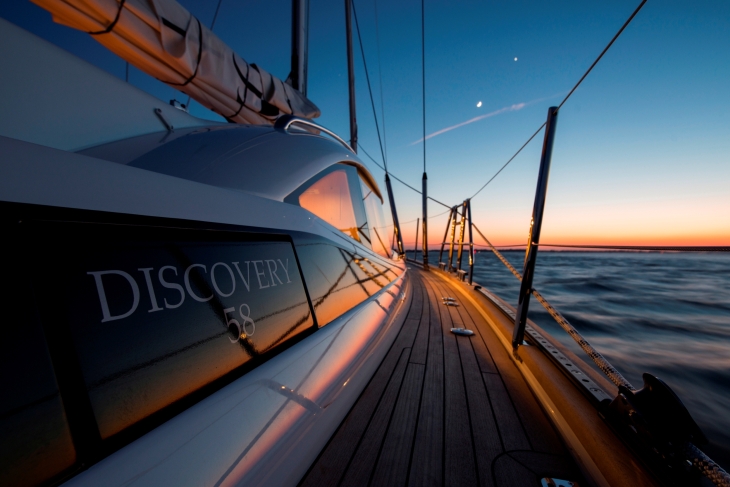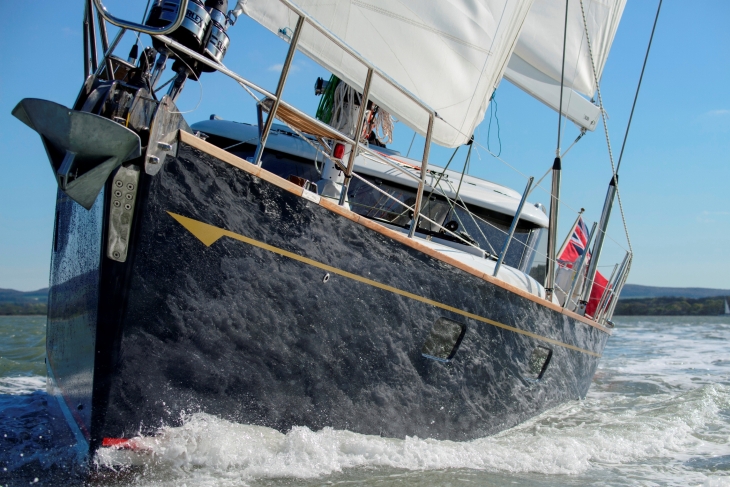
Imagine you’ve reached a certain age, you’ve worked hard all your life, you’ve built and sold your company in that time and your children have flown the nest. What would you want to do next?
For those of us that love sailing, I can only think of one thing a sailor or sailing couple would want to do. Sail to exotic places. Given this scenario you can be forgiven for thinking all that previous hard work is behind you as the next choices you make are going to be hard too – but likely much more enjoyable! So what sailing yacht would you choose?
This was the dilemma that John and Caroline Charnley faced towards the end of the 1990s. They started looking for a perfect short-handed cruising yacht to indulge their passion for sailing, while allowing them to enjoy a level of comfort that few performance sailboats could deliver. Having failed to find the exact solution to meet their needs, they commissioned renowned designer Ron Holland and the Discovery 55 was born – all designed to take two people around the world on the ultimate journey of discovery.
Now nearly two decades on since the birth of their boat and Discovery Yachts in Southampton in the UK, this has resulted in a thriving business with a team of over 100 people and a growing family of over 120 like minded Discovery owners, all sharing in the dream that is bluewater sailing – be they the sailors or the builders. When such a family of folk feel that way, only quality results. Such quality can be seen in all their yachts including the enhanced version of their original 55, the Discovery 58.
Discovery 58
Here are a few images to give you a flavour of the 58.
Luxury onboard
Okay, so you’ve chosen and ordered your dream yacht. Now the hard work starts with refining the specification to your exacting needs, be that colours internal and external, choices of fabric types and styles, push button winches, the sail plan, fridges, air conditioning, a washing machine and the all essential ice maker for your G&T.
From a Victron Energy point of view this all means a lot of stored battery energy required and the customer’s expectation that there will be plenty of it, needs to be met. Running out of ice for your sundowner in that quiet anchorage and having to start a generator is simply not on. How then to achieve that peace?
Energy system choices
Previously delivered Discovery 55s & 58s have been offered with a choice of either 12 x 2V Gel cells of 500 Ah (10hr rate) or 700Ah as an option, along with a 5 or 7 kVA generator.
The latest build Discovery 58 is to be named Karibu which means ‘Welcome’ in Swahili, based on some wonderful safari experiences her owners have had in Africa. Karibu has been highly specified by her owners and is due for delivery in Spring 2016.
First things first though; an energy audit for Karibu. In doing so you can do no better than follow Reinout Vader’s advice in the book ‘Energy Unlimited’. It’s available as a hard copy and for download in a number of languages here: https://www.victronenergy.com/orderbook
Once you’ve carried out an energy audit, discussed how often and for how long you want or have to run the generator each day, it becomes clear with the advent of ever increasing energy demands that a large battery bank and generator is needed, hence the options offered by Discovery. It’s not just the Ah of the pack though as we’ve learned in an earlier blog – Batteries: Lithium-ion vs AGM
Initially when Karibu’s owners and Discovery Yachts looked at the size and type of energy storage they were quite keen to just go with the standard options. This is in part the conservative nature of Discovery where they tend to stick with what is and has been known to work for other owners. However times move on and with the advent of others fitting Lithium-ion systems it soon became clear there were a number of benefits. More of that in a moment. First there were other boats and companies to look at, which is always reassuring when considering a later technology system, They included: TAG Yachts, Morris Yachts and their award winning 48GT, X-Yachts and even the electric propulsion Arviro 10.
With the help of one of Victron Energy’s principal distributors in the UK (Barden UK Limited) plus input from Victron’s technical department and various meetings with Karibu’s owners and Discovery Yachts it was eventually decided that a Lithium-ion energy system was preferable. Naturally Victron Energy are delighted and we commend Discovery Yachts and Karibu’s owners for making this technological step change.
Switching to Lithium-ion
Let’s recap on some of the benefits of Lithium-ion, and in particular Lithium-iron-phosphate (LiFePO4 or LFP) which is the safest of the mainstream Li-ion battery types and the preferred choice for marine systems.
Some of the advantages of a Lithium-ion battery over lead acid batteries such as Gel and AGM are:
- High energy density: more energy with less weight and volume
- High charge currents (shortens the charge period)
- High discharge currents (enabling for example electric induction cooking or stern thruster use)
- Long battery life (up to six times the battery life of a conventional battery)
- High efficiency between charging and discharging (very little energy loss due to heat development)
- Higher continuous power available
Added to this are a number of other benefits which people quite often miss when looking at a large cruising yacht that may not visit marinas often or even be too large for some marinas. With Gel & AGM batteries there is also the slow charge rate once they hit the absorption phase around 80% SOC. In fact it can be even worse with large gel banks that can hit this phase at 60% SOC. This all means longer generator run times and associated costs, not to mention noise. And of course a good 100% charge needs to be done every week or two for longevity of the batteries. In such cases you might only end up with around 30% of the bank capacity that can be cost effectively cycled, whereas with Lithium that can be as much as 80% of the stored capacity available.
In a nutshell it’s not all about the stored Ah available, it is what is actually useable too. A few final points that people also miss is the lack of Peukert effect with Lithium when compared to Gel/AGM, plus the incredible voltage stability that Lithium offers. No voltage droop issues here or in fact any major concerns about the SOC you leave a LFP battery in, when compared to Gel and AGM.
Karibu’s energy system
Here is a diagram of the system concept. A larger format that is easier on the eye is available as a PDF: System concept Discovery 58
The finalised and delivered bill of materials follows, which includes some alterations to the above, not least of which is a 4th battery. The nominal voltage of each 180Ah battery is 26.4V. In this case that gives a 24V 720 Ah bank of 26.4 x 180 x 4 = 19.008 kWh of stored energy of which 80% is useable, which gives Karibu 15.22 kWh of useable energy.
System components delivered
- 1 x Quattro 24/8000/200-100/100
- 2 x Lynx Distributor
- 1 x Color Control GX
- 1 x Digital Multi Control 200/200A
- 4 x Victron Lithium-Ion Battery 24V/180Ah
- 1 x Lynx Ion + Shunt 600A
- 1 x Isolation Transformer. 7000W 230V
- 1 x Shore Power Cord 25m 32A
- 1 x Power Inlet 32A S/Steel
- 2 x Orion 24/12-5
- 1 x Orion 24/12-70
- 1 x Skylla-TG 24/50 (1+1) 90-265VAC
- 1 x Skylla Control
Karibu’s lithium-ion energy system installation
Below is an overhead photograph of two of the four batteries installed, along with a Lynx Distributor and Lynx Ion + Shunt.
In recognition of the fact that at some future point in time batteries may need to be lifted out for one reason or another, Discovery Yachts have thought ahead and fabricated a lifting tool to fasten to the batteries in turn. This will make lifting each battery easier, as they weigh 55 kg each. A lifting eye will be provided above the headlining, over the battery bins, for a block and tackle.
Conclusion & Credits
As the build of Karibu progresses we hope to bring you updates and pictures of that, plus information on the initial cruises and how this first Victron Lithium-ion system for Discovery Yachts performs for all concerned, when compared to the old Gel system.
My thanks in compiling this blog goes first and foremost to Karibu’s owners and Richard Andrews of Discovery Yachts. My thanks also to Johannes Boonstra of Victron Energy and recent Victron Energy distributor award winner Barden-UK.
Feel free to comment or ask any questions you may have in the Disqus comments section below.
John Rushworth.

















 #victronenergy #adventure
#victronenergy #adventure
 ELECTRICS
ELECTRICS 
